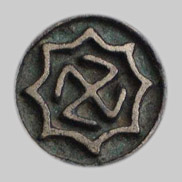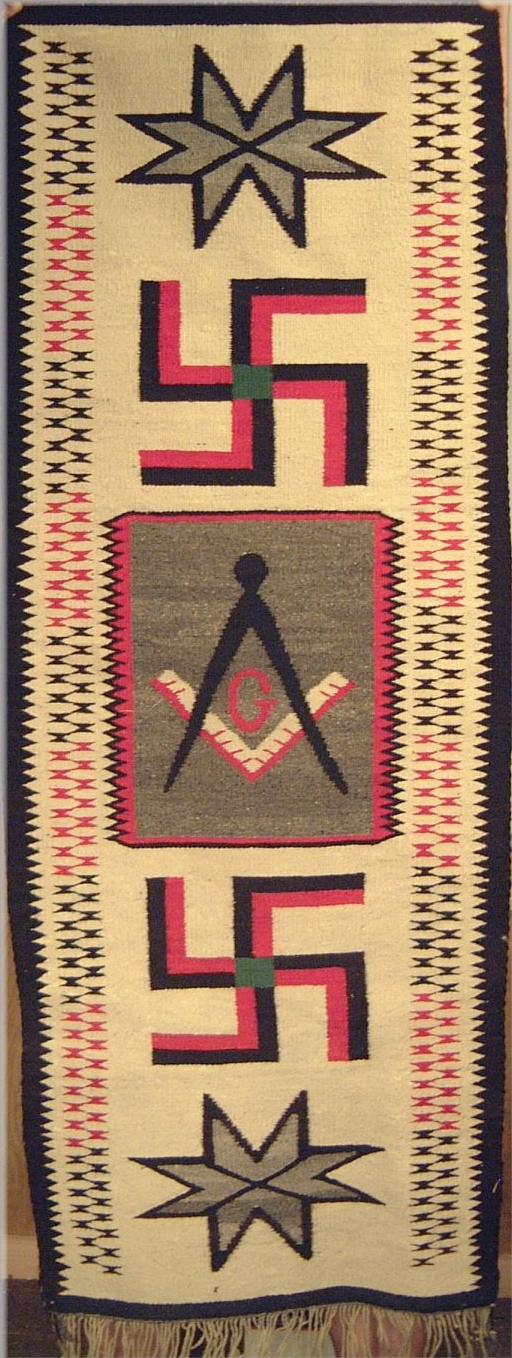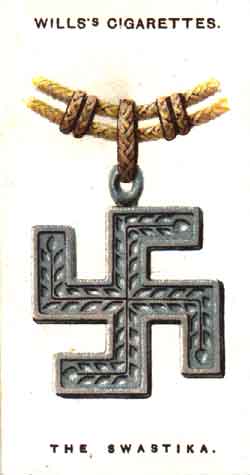|
|
|
The word swastika is derived from the Sanskrit, svastikah, which means 'being fortunate': SVASTI-, can be divided into two parts: SU- 'good; well', and -ASTI- 'is'; -ASTIKAH means 'being'. While it has also been said that it is derived from Sanskrit words meaning "health mark" and that the reverse swastika represents darkness, misfortune, and suffering, this etymology is unsupported. The meaning, if any, of the direction of the swastika arms is ambiguous. While Jainism represents the swastika in a clockwise manner, Tibetan Yungdrung Bön represents it counter-clockwise and there is little consistency in its use in the Americas. Many First Nations adorn their houses and doors with this sacred symbol, which is an auspicious symbol bearing good luck and there are many ancient graves in Ireland and England marked with swastikas. Also noteworthy is the swastika’s use as the specific emblem of Ganesha, the Hindu god of good luck, who is also represented as an elephant.
In the early part of the twentieth century Rudyard Kipling used the swastika as his coat-of-arms, Coca Cola© made a swastika-shaped watch fob and American pilots used it on their planes when they fought for the French in World War One. It was the symbol for the Ladies Home Journal sponsored Girls' Club and the Boy Scouts of America. A town in Ontario was named Swastika in 1911 because of a gold strike.
According to Kveldulf Gundarsson, it is: "the sign of the sun’s strength as the unstoppable whirling might of Will. It is one of the holiest and oldest signs in the world, known in almost every tradition"
"...two intersecting straight lines with angled arms, is a noted Hindu symbol. It is also known as the Swastika and Fylfot, and a specimen appearing on a Roman altar in Alnwick Castle has been described by Lord Broughton as denoting the hammer or mace of the Scandinavian god Thor [Thunar]. It is seen with Thor on various medals and on Runic monuments, and also occurs in the minster at Basle. With reference to the connection of the Scandinavians with Italy, Sir William Betham ("Etrurio Celtica") shows an Etruscan coin with this symbol on it."1
"... Swastikas appear on Paleolitic carvings on mammoth ivory from the Ukraine, dated ca. 10,000 B.C. Swastikas figure on the oldest coinage in India. Persia, Asia Mior, and Greece represented the rotating axis mundi with the symbol of a swastika. On a Boeotian amphora of the 7th century B.C., the swastika was presented as a sacred sign of the Goddess Artemis. It also represented many other deities from Iceland to Japan, Scandinavia to North Africa. It was much used in Troy and Mycenaie before the 13th century B.C. ... In Japan, the reborn Amida, "Buddha of Immeasurable Light", wore a left-handed swastika carved on his breast. A similar left-handed swastika was the sign of Thor’s hammer on Scandinavian coins. ... Trojan images of the Great Goddess showed a swastika within a female triangle on her belly, indicating the hidden god prior to his next rebirth. Early Christians adopted the swastika to represent Christ, calling it a crux dissimulata or disguised cross. It was also called the crux gammata ... because it showed the Greek letter gamma four times repeated. To Saxons it was fylfot, translated either "four-foot", referring to the four heavenly pillars at the corners of the earth, or "fill-foot", referring to the Christian habit of filling in the foot of a church window with swastikas. ..."2
Religious and cultural usage
   Shao Lin Temple.
Shao Lin Temple.
   Falun Gong (1998)
Falun Gong (1998)
   The swastika in contemporary Japan
Historical usage
The swastika in contemporary Japan
Historical usage
   Stone masons' mark (98).
Stone masons' mark (98).
   The Svastika by Mrs. Murray-Aynsley. AQC vol. iv (1891)
The Svastika by Mrs. Murray-Aynsley. AQC vol. iv (1891)
   Bronze Age Sun and Fire Symbols AQC vol. iv (1891) p. 31.
Bronze Age Sun and Fire Symbols AQC vol. iv (1891) p. 31.
   Note on the Svastika by S. C. Pratt. AQC vol. iv (1891)
Popular usage
Note on the Svastika by S. C. Pratt. AQC vol. iv (1891)
Popular usage
   Alexander Nevsky: Soviet war propaganda.
Alexander Nevsky: Soviet war propaganda.
   As a warding sign.
As a warding sign.
   "Swatsticka" from Fontaine Fox’s Toonerville Trolley
"Swatsticka" from Fontaine Fox’s Toonerville Trolley
   Used for shock value in a "biker" movie.
Used for shock value in a "biker" movie.
   Identified with society's violent fringe.
Further information is available off this website at swastika-info.com and manwoman.net
1.
Identified with society's violent fringe.
Further information is available off this website at swastika-info.com and manwoman.net
1. Robert Freke Gould History of Freemasonry. London : Thomas C. Jack, 1883. pp. 455-66.
2. Robert Freke Gould History of Freemasonry. London : Thomas C. Jack, 1883. pp. 455-66.
2. Barbara G. Walker, The Woman’s Encyclopedia of Myths and Secrets New York : Harper & Row, 1983. Barbara G. Walker, The Woman’s Encyclopedia of Myths and Secrets New York : Harper & Row, 1983.
|
![[Grand Lodge]](../../images/hedn.jpg)


